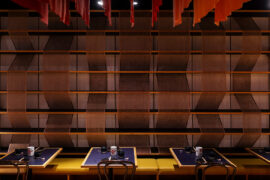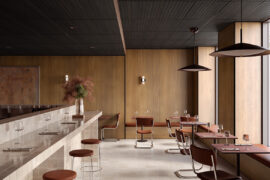Biasol has looked to Japanese craftsmanship and materiality to create a contemporary design inspired by Tokyo’s izakaya bars.
Tokyo’s intimate izakayas – Japan’s answer to the pub and tapas bar – inspired chef Tatsuya Yamazaki’s new restaurant Y14 Japanese Seafood Kitchen & Bar in Sandringham, Melbourne. Designed by Biasol, the interior of Y14 reflects Japan’s rich history of traditional craftsmanship and natural materials, with timber, terracotta and ceramics adding intricacy and dimension to the space.
Functionally, the space provides for interior and alfresco dining, and a central sushi and seafood bar for chef Yamazaki to showcase the precision and freshness of Japanese cuisine. Aesthetically, the design concept is driven by materiality and Japanese craftsmanship, creating a sense of lightness and contrast throughout.
An elegant framework of timber joinery is suspended from the ceiling and descends over the seating and bar to form display shelving with sake bottles and pockets of greenery around the perimeter of the restaurant. “The almost weightless timber elements give it a distinctly Japanese feel,” says Jean-Pierre Biasol, Principal at Biasol. “It becomes a sort of lightweight bulkhead that floats above the space and offers a sense of privacy and intimacy to the sushi chef and diners at the bar.” In developing the lattice-like joinery, the design team researched traditional Japanese craft techniques and joints, drawing inspiration from the method of interlocking pieces without glue or nails.
The focus on materiality continues for and around the bar. Inspired by the Japanese tradition of terracotta, the bar is faced with terracotta bricks that are placed on their sides to reveal their hollow cores, and lit with warm LED lighting to accentuate their colour and texture. Behind the bar, the splashback is finished in pale grey-green tiles from Japanese ceramic specialist Inax, providing a faceted, tonal surface that shifts with the light.
Full-height folding glass doors open the interior space to the pavement seating; and warm, light-hued timber clads the walls, setting off the high-contrast black Wishbone chairs and bar stools. While the Wishbone is Hans Wegner’s Danish masterpiece, it reflects the focus on craftsmanship and natural materials in the Scandinavian and Chinese traditions.
Timeless design is often achieved by taking a modern approach to tradition. By looking to centuries-old craftsmanship and materiality, Biasol has created a contemporary design for Y14, where modern dishes are similarly based on tradition.
INDESIGN is on instagram
Follow @indesignlive
A searchable and comprehensive guide for specifying leading products and their suppliers
Keep up to date with the latest and greatest from our industry BFF's!

London-based design duo Raw Edges have joined forces with Established & Sons and Tongue & Groove to introduce Wall to Wall – a hand-stained, “living collection” that transforms parquet flooring into a canvas of colour, pattern, and possibility.

Welcomed to the Australian design scene in 2024, Kokuyo is set to redefine collaboration, bringing its unique blend of colour and function to individuals and corporations, designed to be used Any Way!

Designed by Kelly Ross, the newest addition to Bisa Hospitality’s portfolio represents more than just another restaurant opening.

With the inaugural Glenn Murcutt Symposium set to take place in Sydney in September 2025, Pritzker Prize-winner Francis Kéré receives the Murcutt Pin.

Despite its long and rich history, signwriting is a profession in decline. Will Lynes’ new show, Oily Water at Canberra Glassworks, aims to showcase the techniques of the trade to highlight its potential in design.
The internet never sleeps! Here's the stuff you might have missed

Australian designed and manufactured, Laminex Architectural Panels transform timber design aesthetics with cutting-edge technology

As French-Lebanese Architect Lina Ghotmeh prepares for lectures in Melbourne and Sydney, we hear about the philosophy shaping her internationally celebrated practice.